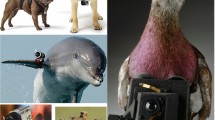Abstract
The notion of a virtual camera for optimal 3D reconstruction is introduced. Instead of planar perspective images that collect many rays at a fixed viewpoint, omnivergent cameras collect a small number of rays at many different viewpoints. The resulting 2D manifold of rays is arranged into two multiple-perspective images for stereo reconstruction. We call such images omnivergent images, and the process of reconstructing the scene from such images omnivergent stereo. This procedure is shown to produce 3D scene models with minimal reconstruction error, due to the fact that for any point in the 3D scene, two rays with maximum vergence angle can be found in the omnivergent images. Furthermore, omnivergent images are shown to have horizontal epipolar lines, enabling the application of traditional stereo matching algorithms, without modification. Three types of omnivergent virtual cameras are presented: spherical omnivergent cameras,center-strip cameras and dual-strip cameras.
Similar content being viewed by others
References
Baker, S. and Nayar, S. 1998. A theory of catadioptric image formation. In Proc. Sixth Int. Conf. on Computer Vision, pp. 35–42.
Bolles, R.C., Baker, H.H., and Marimont, D.H. 1987. Epipolar-plane image analysis: An approach to determining structure from motion. Int. J. of Computer Vision, 1(1):7–55.
Chen, S.E. 1995. Quicktime VR-An image-based approach to virtual environment navigation. In Proc. SIGGRAPH 95, pp. 29–38.
Gortler, S.J., Grzeszczuk, R., Szeliski, R., and Cohen, M.F. 1996. The lumigraph. In Proc. SIGGRAPH 96, pp. 43–54.
Huang, H.C. and Hung, Y.P. 1998. Panoramic stereo imaging system with automatic disparity warping and seaming. Graphical Models and Image Processing, 60(3):196–208.
Ishiguro, H., Yamamoto, M., and Tsuji, S. 1992. Omni-directional stereo. PAMI, 14:257–262.
Kang, S.B. and Szeliski, R. 1996. 3-D scene data recovery using omnidirectional multibaseline stereo. In Proc. Computer Vision and Pattern Recognition Conf., pp. 364–370.
Katayama, A., Tanaka, K., Oshino, T., and Tamura, H. 1995. A viewpoint dependent stereoscopic display using interpolation of multi-viewpoint images. In Proc. SPIE, vol. 2409A, pp. 21–30.
Kumar, R., Anandan, P., Irani, M., Bergen, J., and Hanna, K. 1995. Representation of scenes from collections of images. In Proc. IEEE Workshop on Representation of Visual Scenes, pp. 10–17.
Levoy, M. and Hanrahan, P. 1996. Light field rendering. In Proc. SIGGRAPH 96.
Mann, S. and Picard, R. 1994. Virtual bellows: Constructing high-quality images from video. In Proc. First Int. Conf. on Image Processing.
McMillan, L. and Bishop, G. 1995. Plenoptic modeling: An image-based rendering system. In Proc. SIGGRAPH 95, pp. 39–46.
Nayar, S.K. and Karmarkar, A. 2000. 360 × 360 mosaics. In Proc. Computer Vision and Pattern Recognition Conf., pp. 388–395.
Okutomi, M. and Kanade, T. 1985. A multiple-baseline stereo. IEEE Trans. on Pattern Analysis and Machine Intelligence, 15(4):353–363.
Pajdla, T. 2001. Epipolar geometry of some non-classical cameras. In Proceedings of Computer Vision Winter Workshop, Slovenian Pattern Recognition Society, pp. 223–233.
Peleg, S. and Ben-Ezra, M. 1999. Stereo panorama with a single camera. In Proc. Computer Vision and Pattern Recognition Conf., pp. 395–401.
Peleg, S. and Herman, J. 1997. Panoramic mosaics by manifold projection. In Proc. Computer Vision and Pattern Recognition Conf., pp. 338–343.
Peleg, S., Pritch, Y., and Ben-Ezra, M. 2000. Cameras for stereo panoramic imaging. In Proc. Computer Vision and Pattern Recognition Conf., pp. 208–214.
Seitz, S.M. 2001. The space of all stereo images. In Proc. Eighth Int. Conf. on Computer Vision, pp. 26–33.
Shum, H.-Y., Kalai, A., and Seitz, S.M. 1999. Omnivergent stereo. In Proc. Seventh Int. Conf. on Computer Vision, pp. 22–29.
Shum, H.-Y. and Szeliski, R. 1999. Stereo reconstruction from multiperspective panoramas. In Proc. Seventh Int. Conf. on Computer Vision, pp. 14–21.
Szeliski, R. 1996. Video mosaics for virtual environments. IEEE Computer Graphics and Applications, 16(2):22–30.
Wood, D.N., Finkelstein, A., Hughes, J.F., Thayer, C.E., and Salesin, D.H. 1997. Multiperspective panoramas for cel animation. In Proc. SIGGRAPH 97, pp. 243–250.
Author information
Authors and Affiliations
Rights and permissions
About this article
Cite this article
Seitz, S.M., Kalai, A. & Shum, HY. Omnivergent Stereo. International Journal of Computer Vision 48, 159–172 (2002). https://doi.org/10.1023/A:1016342731674
Issue Date:
DOI: https://doi.org/10.1023/A:1016342731674




